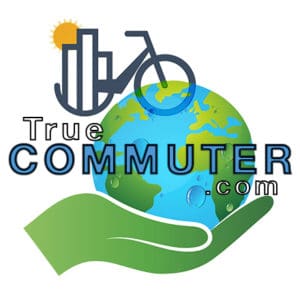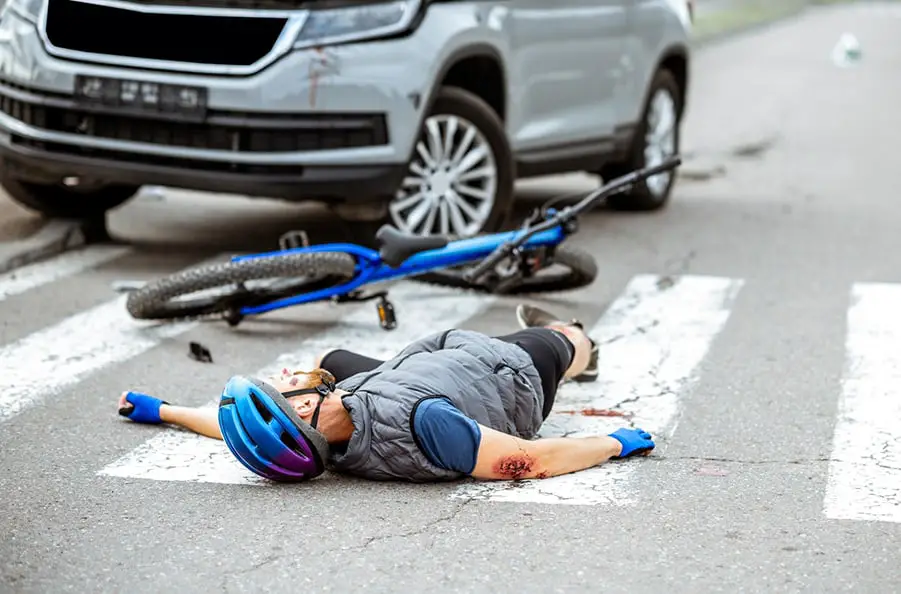
Of all the ways to commute to work, bike commuting offers a whole host of benefits for your body, your mind and your wallet. The cash-saving benefits alone make it a really attractive proposition but according to Open Access Government, there are only about 6% of the population cycling to work in the UK but is this because bike commuting is dangerous?
To consider whether bike commuting is dangerous we need to look at the statistics. It is claimed that 18,477 cyclists were injured in road accidents in 2016 in the UK, including 3,499 who were killed or seriously injured. These statistics include all cyclists and not just bike commuters.
There are many reasons for people to select alternative means of transport for their commute to work over bike commuting but according to a YouGov poll, surveying over 1000 workers about their attitudes to cycling, 26% of them were deterred by the risk of accidents. In this article we are going to answer the question – Is Bike Commuting Dangerous?
In addition to this Pedal cyclists accounted for 6% of total road deaths in 2018 (Department for Transport).
Whilst these numbers may seem alarmingly high, there are many ways to ensure you stay safe on your bike commute. Here we share our top tips (some of them from personal experiences) on staying safe on your bike commute.
Our top tips for a safe commute are:
- Wear our recommended safety gear
- Beware of other road users
- Consider your riding style
- Follow the Highway Code
- Maintain your bike
- Protect yourself from hostility
- Consider your route
- But most importantly, enjoy it and do not let this list put you off (ok this is not really a safety tip, that’s why the article is for 7 safety tips and not 8)!!
1. Wear our Recommended Safety Gear
Protect Your Head

Hopefully, this one is obvious but you should always wear a helmet during your bike commute. In many countries, there is no legal requirement to wear a helmet but to not is putting your life in the hands of the gods.
Even at low speed collisions and accidents, the risk of serious injury is significantly higher without a helmet. Modern designs are stylish and comfortable so there really is no excuse not to wear one. Your life may literally depend on it.
A study from 2016 collected data from over 64,000 cyclists around the world and found compelling evidence that wearing a cycle helmet reduces the risk of serious head injury by almost 70% and fatal head injury by 65%. It is the largest review on cycling and helmets to date. The study also found that the risk of sustaining a general head injury is reduced by 51% and facial injury by 33% when a helmet is used (Olivier, Creighton, 2016).
Cycle helmets should always be fitted and worn correctly, be free of any damage, and marked with the safety standard EN1078 (for adults) or EN1080 (for children).
You can view our recommended helmets here.
See and Be Seen
Making sure you are visible to other road users is an essential safety tip for your bike commute. Not only do you need to be able to see in ALL conditions, you need to be seen too.
It is common for people to neglect this in the day and think it is only an issue for night riders. This is not the case. Visibility can vary drastically through the day even on bright days. Do you ride under shady trees? Do you ride and the weather takes a turn for the worst and goes dark? You need to make sure you are prepared for these conditions and not just for night conditions.
This means you need to have lights on your bike mounted on the front and rear of the bike as an absolute minimum.
Your bike’s front light’s function is to allow you to see the path or road ahead of you and any possible obstacles in your way. In addition to this, you will be visible to other read user and pedestrians. The rear light is often weaker than the front but equipped with flashing mode. This light allows you to be visible by other drivers on the road.
You can also get lights built into helmets and on your body to make yourself more visible.
In addition to lights, you should also ensure the largest visible part of a bike, YOU, are easy to see too. This will mean wearing reflective clothing or other accessories that will reflect light from other sources such as street lights and car headlights.
There are many options for reflective clothing. These range from reflective vests and bands, that you can add over the top of other clothes, to reflective jackets that are waterproof, warm and increase the chances of being seen. These Firefly Buddy Reflective Vest and Bands are a very affordable option and protecting yourself need not be expensive if you go for this option.
2. Beware of ‘Other’ Road Users
When you are on your bike commute and riding on the road, you are just another road user. You are the hold up, you are the traffic. In the same way you expect others to look after and watch out for you, you should do the same for other road user.
There is a constant debate between motorists and cyclists on who is more welcome on the road. The truth is that both have a right to be there and cyclists need to play their part in making it a problem-free environment. So watch out for others, be courteous and polite and make sure you are part of the solution to this ongoing debate.
When cycling, you are harder to spot than other, larger road vehicles and you are not audible in noisy traffic. This is a fact of life and you will need to adjust for this. If cycling in traffic you can very easily fall into a vehicle blind spot and so you should be aware that sometime motorists will not see you.
In all cases you should consider your riding style including road position, defensive riding and common sense as this will be the best course of action to keep you safe from other road users.
3. Consider Your Riding Style
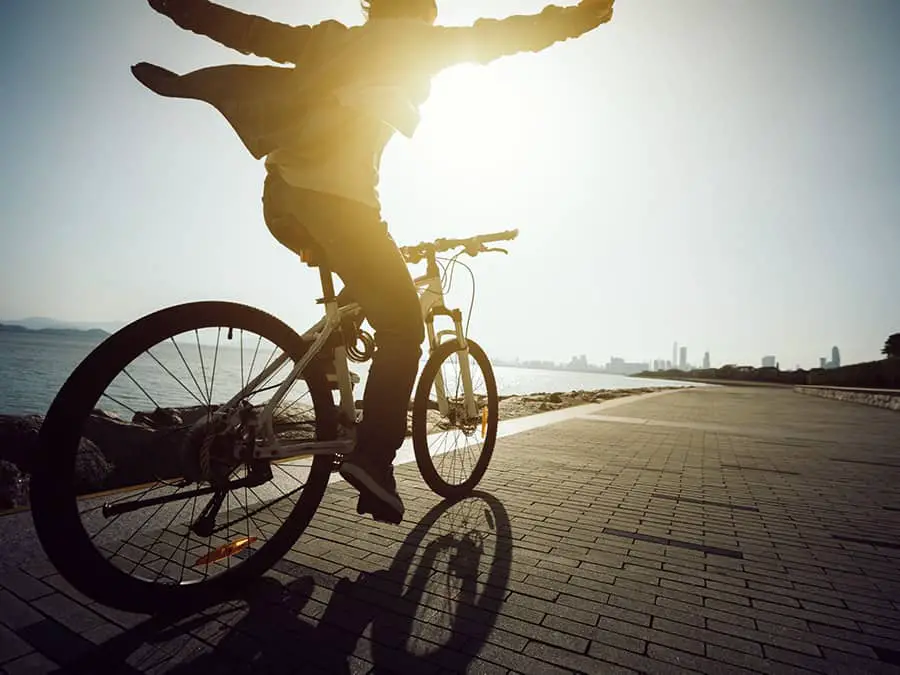
In other words, slow down, you are NOT in the Olympics. You don’t have to break any world records on your bike commute. It is much better to guarantee a safe arrival rather than risking accident and injury.
Obviously there are times where you want to try to beat your top speed record, and there may be segments of your route that allow it, but for the most parts it is better to consider the hazards around you and give yourself that extra time to react in case the unexpected happens.
The risk is not only to yourself when you cycle to work. You have to consider other road users and pedestrians. Bikes are difficult to spot and very quiet as a mode of transport. Distracted pedestrians could quite easily miss you and step out into the road resulting is an injury for both parties. You have a responsibility to keep yourself and others safe and so consider your speed, especially through busy areas in the rush hour.
Adopting a defensive riding style is important to keep you safe and will make you more aware of your cycling and generally a more considerate road user. Don’t be the person who gives road cyclists a bad name!! The YouTube video below will give you a great article.
Overtaking with caution
Overtaking slow-moving cyclists, idle busses or parked cars is sometime necessary on a busy bike commute, but this should be done with caution.
When cycling passed parked cars you always need to be aware of the risk to car doors opening. This can happen when you least expect it. It happened to me once when there was someone emptying the boot of the car so I assumed it was empty and then a passenger exited. Luckily I managed to stop in time but it was a close one. This can be a common occurrence.
If possible, when overtaking parked cars, try to give them the width of the door of space for the unexpected. This tip will also ensure you take up a more suitable road position and discourage drivers to overtake you in a tight spot and so they will be more reluctant to squeeze past you, putting you at risk. There is nothing worse than a car passing too close when cycling.
It may be necessary to anticipate danger and slow your speed appropriately so you have time to react to anything unexpected happening.
When overtaking cars, or other vehicles, it is also important to identify when they may pull out in front of you. Bike are difficult to see in wing mirror and even the most considerate and vigilant driver can make a mistake and pull out on you. This goes for buses and other vehicles too.
You also have to bear in mind the impatient driver who will see a bike and try to pull out before them so their journey is not slowed by following a bike. Watch out for these morons too!! They don’t care about you as much as their journey, and there are far too many of these!!
An often overlooked hazard for bike commuters is pedestrians. We think we are safe from the deadly pedestrian. Not necessarily. Pedestrians are often distracted, in a rush and not often looking out for you silently approaching on your road bike. It is easy for a pedestrian to step out in front of you.
A good riding position can take some risk out of pedestrian hazards.
Take a Good Road Riding Position
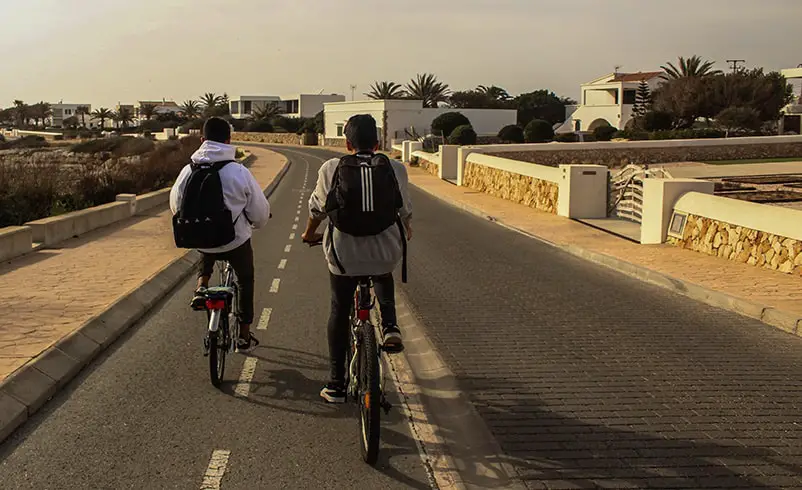
As a new bike commuter, you may be intimidated by traffic on the road and inevitable you will try to hug the curb to make sure you are out of the way of other vehicles. This is not a safe riding position on the road and contrary to popular belief, you should be taking up a much more central position.
The gutter of any road is the place where you will find the most debris, potholes and other items dangerous for a road cyclist. It is where all the mess gets put following a collision, where people throw their litter and where the local authorities don’t bother fixing or patching up in a lot of cases. It’s horrible.
So where should you ride? Drivers are obliged by the Highway Code (Rule 163) to give you ‘at least as much room as a car’ when overtaking. That means drivers should be getting across to the other lane when overtaking you which means you can command more of the space than you think.
You should look to be riding a third of the way into the lane. This is known as the primary position and should be taken when you are travelling at reasonable speeds. You should not see yourself as an obstacle for traffic to navigate, you are part of the traffic stream and should look to command the road like any other road user.
By taking a more central position, drivers are forced to respect your space more and will inevitably give you more room than squeeze past (there will still be the odd idiot that likes to skim your knee).
This riding position will also make it easier for other road users to clearly see you making it a much safer option.
If you are causing a large traffic build up due to slower speeds, and if there is a clear road in front of you, you may then opt to take up a secondary position.
The secondary position is roughly 1 metre to the left of the traffic flow and not less than 0.5 metres to the edge of the road. This may be appropriate if the road is wide enough to allow safe overtaking, and the rider’s safety is not reduced by riding in this position.
The secondary position is useful on quieter roads with fewer parked cars at it allows more space for passing cars when it is safe to do so but riders shouldn’t be afraid to take a more central position in some circumstances.
Both of these riding positions are intended to help put you in control of the dangers around you and help to improve drivers behaviour to avoid accidents and collisions.
Communicate with Other Road Users Clearly
It is essential that you always look to communicate your intentions whilst on your bike commute. As with any road transport it is important that you let other know where we are going, and important to know where others are going too.
There is great advice from Cycle Scheme on the types of hand signals available to the bike commuter. The obvious ones are putting out an arm to signal to turn right or left. In most cases, this will be sufficient but there are others dictated in the Highway Code and others that have become common practise.
The most common I have personally used are:
- Signalling to turn right or left
- Communicating I am slowing down (flapping arm up and down)
- A sweeping, beckoning gesture with your right arm to tell drivers to ‘Please overtake, driver behind. It’s safe to do so.’
- A wave or a thumbs up to signal my thanks to a considerate driver.
It is worth noting that signals are optional according to the Highway Code and do not need to be used if there is no traffic around you. Be considerate though, and communicate with others, for everyones safety.
Another way to communicate is to make eye contact with other drivers. Making eye contact means you both know you have seen each other and it will be much easier to understand each others intentions. Once eye contact is maintained you can be more confident that the driver won’t do anything unexpected.
If you are riding on the road, or anywhere else for that matter, don’t be afraid to let people know you are coming. You can verbally shout to signal to others but the bell is a much easier choice. That’s right, the bell is not just for little girl’s bikes, it’s for all bikes, yes your bike too!! The bell is efficient, less intrusive than shouting and frankly easier.
The YouTube video below will give you a great resource for riding defensively.
4. Follow the Highway Code
Section 59 to 82 of the Highway Code covers the rules around cycling on the road. It is there to ensure you stay safe and sets the standards for all road uses.
If you are like me, you may go years without looking at the Highway Code. This standard is regularly updated and should be refreshed regularly for the latest rules to keep all road users safe.
5. Maintain Your Bike
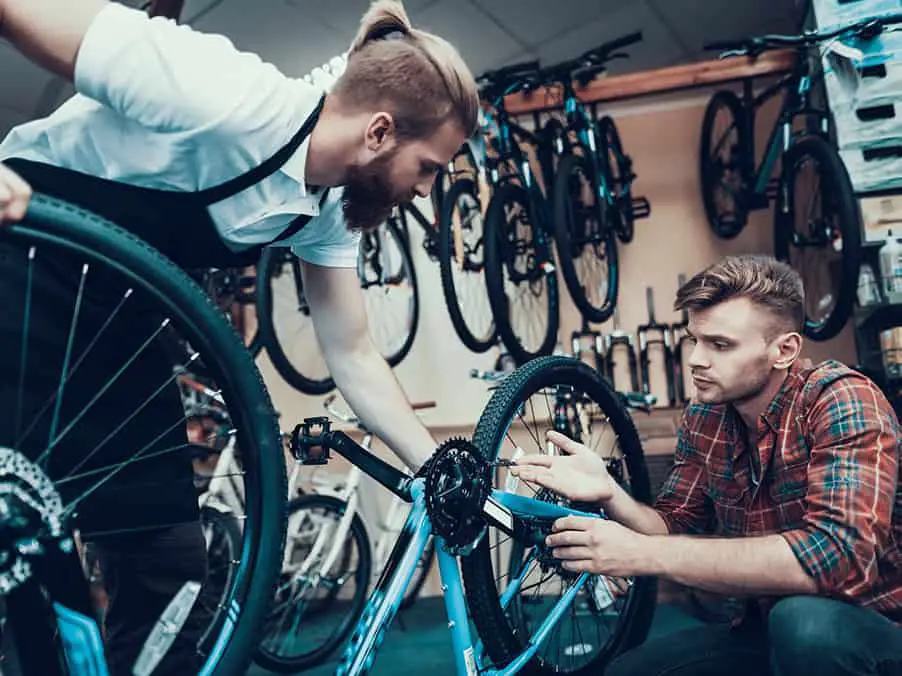
Hopefully, this tip is an obvious one and so I won’t go into too much detail here but it is vital you overcheck your bike before each ride and make sure you regularly maintain it.
You don’t have to be an accomplished mechanic for this. A few simple checks are all that is needed to keep your bike safe. The 5 simple checks reccomended before your commute are:
- Check tire quality and tire pressure before your ride.
- Check the wheels and ensure the quick release mechanisms are tight and secure
- Check the brakes, are they working adequately
- Check the gear shifting, ensure this is operating correctly, check the chain to ensure it is lubricated adequately
- Check your lights, in all modes
It really is as simple as that. Obviously a more robust and thorough service should be performed annually to make sure there are no major issues with your bike. You can either do it yourself or take it to a specialist. Service packages, such as these from Evans Cycles for example, range from approximately £35 up to £120 for a bronze or gold service.
If you want to give it a go yourself, the YouTube video below gives you a great starting point.
6. Protect Yourself
A study conducted by HPI revealed a quarter of UK road users have physically confronted another road user during a road rage incident with cyclists being considered in the top three most “infuriating” road users.
Whether you like it or not, at some point during your bike commuting life you will be confronted with an angry road user. In most cases this will be the aggravated wave of an arm, gesture or verbal abuse, but road rage incidents are reportedly becoming more physical.
In addition to this, as a bike commuter, you are at an increased risk of being a victim of crime, be this through personal attack, theft or vandalism. According to crime data, 376,000 bicycles are stolen every year in the UK. This works out at about one bike stolen every 90 seconds.
Whilst there are some alarming stats out there, this incidents very rarely put you in physical danger but it is something you should prepare for to help keep you safe.
You can protect yourself from road rage incidents by being a generally considerate road user, be polite and courteous and ride inline with the rules of the Highway Code. If you make a riding mistake, acknowledge it through the raising of an apologetic hand. You won’t stop all incidents but this will reduce the risk. In terms of verbal abuse, ignore it. If you try to do the right thing you will reduce the risk of incidents.
In terms of physical abuse, follow the next few guidelines to help reduce the risk and protect yourself.
- Carry a personal alarm – such as this one from Safe Nomad.
- Tell someone about your commute, your route and rough timings.
- Take a well lit and more populated route
To reduce the risk of bike theft, below are a few tips:
- Buy a great locking system – such as this one from Via-Velo.
- Register your bike – Bikeregister.com is the UK’s leading online bicycle registration initiative that is aimed at reducing bicycle theft and is used by every police force.
- Remove accessories
- Find a secure public place to lock up your bike
7. Consider your Route
Whilst is may seem like a city centre, traffic heavy route would be the most dangerous, this is not always the case. City centres are catering more and more for cyclists with the addition of dedicated cycle lanes and traffic control measure. What’s more, other road users are much more aware of the potential for cyclists within the city.
If your route takes you on country roads or more quiet roads, then road users may not expect to be confronted with cyclists and, in addition, routes are often more narrow and have less room for passing cars and overtaking putting the bike commuter at further risk.
Consider this when picking your route.
Don’t Let This Article Put You Off!!!
Every time you walk out of your front door and leave the sanctuary of the home, you put yourself at an increased risk of injury. This is a fact of life and whilst bike commuting may increase your risk further, it is still statistically unlikely you will have a problem.
The benefits of bike commuting far outweigh the risks and if you follow the tips of the article you minimise the risk of an incident occurring. Don’t let this article put you off. I still encourage you to give it a go, leave the car at home and reap the health, environmental and money-saving benefits cycling to work can bring.
